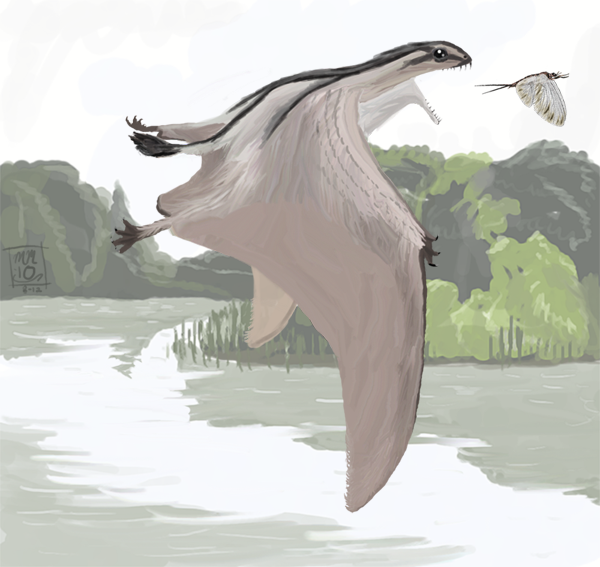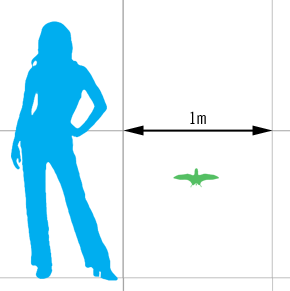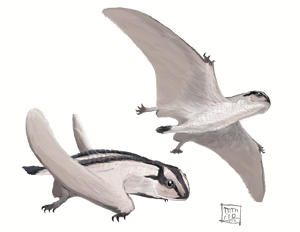home > natural history
Dendrorhynchoides curvidentatus
"curve-toothed tree rhamphorhynchoid"

Buy a print
Dendrorhynchoides is among the smallest known pterosaurs. The only known specimen is near adulthood and measures only 30 cenitmetres from wingtip to wingtip. It's also a member of possibly the stangest pterosaur group known, the anurognathids, or "frog jaws." These tiny flying reptiles had wide, squat skulls filled with tiny teeth, unlike the long, slender, toothy or beaked jaws of most other pterosaurs.
Thanks to several well-preserved specimens from both Germany and China, we know quite a bit bot the anatomy of these flying, furry, frog-like creatures. All pterosaurs were probably covered in a fur-like pelt of pycnofibres, but anurognathids seem to have been particularly well endowed with long, dense fuzz. From fossils of the larger Middle Jurassic Jeholopterus, we know that this pelt extended even to the tips of the jaws, and some have suggested that, like some similarly wide-mouthed modern birds (nightjars and frogmouths), anurognathids may have had some kind of sensory whiskers for catching or locating insects on the wing. The stiff, outer wings were mostly naked, though the pelt may have extended onto the flexible inner wing. The edges of the wing tips also had a fringe of pycnofibres that may have helped anurognathids like Dendrorhynchoides fly more quietly in order to better ambush prey, like the freyed primary feathers of owls.
The tail of Dendrorhynchoides was probably fairly short, unusual for a non-pterodactyloid pterosaur. However, the tail of the only known specimen was enhanced with a fake extention by fossil dealers prior to study, leading scientists at first to assume it was a true rhamphorhynchid, not an anurognathid, despite the characteristic frog-like mouth. We do know, again thanks to Jeholopterus, that the bony tail of anurognathids supported a short soft-tissue extension and an especially large spray of pycnofibres. It was probably connected to the hind leg portion of the wing, or uropatagium, and the main wing connected to the leg at the ankle, giving Dendrorhynchoides a broad-winged, bat-like silouette compared to other pterosaurs, which often had narrower wing chords and small uropatagia.
It is likely that the tiny Dendrorhynchoides lived in the trees of its Yixian formation forest habitat, using its broad and highly manuverable wings to flit after insects, which it captured in its disproportionately large, gaping mouth.
Image Details:
Media: Digital painting in Adobe Photoshop CS3
License:
ALL RIGHTS RESERVED
DESCRIPTION
Length: 10cm (4in)
Wingspan: 30cm (1ft)
Weight: 40g (1.4oz)
Location: Yixian Formation, Liaoning, China
Time: Aptian age, Early Cretaceous (125 Ma)
CLASSIFICATION
Kingdom: Animalia
Phylum: Chordata
Class: Stem-Aves
Order: Pterosauria
Family: Anurognathidae
Genus: Dendrorhynchoides
Species: D. curvidentatus
SYSTEMATICS
Sauropsida
Diapsida
Archosauria
Ornithosuchia
Pterosauria
Anurognathidae

